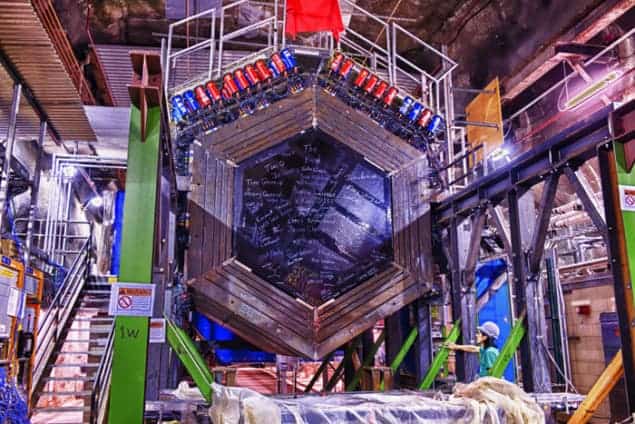
The first ever transmission of information using a beam of neutrinos has be achieved by physicists in the US. The demonstration is highly preliminary – it operates at less than 1 bit/s – and will require a lot of development before it can have any useful application. Nevertheless, the work proves a concept that physicists have been contemplating for years and that could ultimately be used in situations where other means of communications are not feasible.
Electromagnetic radiation – particularly at visible, microwave and radio wavelengths – is today’s carrier of choice for moving information. It is easy to transmit, easy to detect and can carry a lot of information. However, there are some situations where it does not work very well. One example is the transmission of information to nuclear submarines, which can remain submerged almost indefinitely. The problem is that seawater is opaque to electromagnetic radiation at the wavelengths short enough to transmit information at a useful rate. Submarines therefore have to float a wire antenna to the surface, which restricts their speed and depth, making them easier to detect.
A ghostly solution
For ease of transmission through any material including seawater, nothing beats the neutrino. The ghostly particle is affected only by the weak nuclear force and, very faintly, by gravity. As a result, it can pass through almost everything and interacts with virtually nothing. A neutrino could easily pass through 1000 light-years of lead, so an ocean would pose no problem whatsoever. Indeed, some scientists have suggested that advanced extraterrestrial civilizations could communicate across vast distances in space using neutrino beams.
Although neutrino-based systems have been proposed here on Earth since the 1970s, they have all come up against the same problem: how to detect the neutrinos at the receiving end when the vast majority of the particles will pass straight through any detector. To detect enough neutrinos to transmit information at a reasonable rate, either an extremely intense neutrino source or a very large detector (or both) would be needed. In 2009, for example, Patrick Huber of Virginia Tech University came up with the idea of using the hull of a nuclear submarine to detect the radiation given off when neutrinos interact with the surrounding seawater. However, Huber admitted that such a scheme would also require an intense source of neutrinos that would cost several billion dollars to build.
At around the same time, Daniel Stancil at North Carolina State University was thinking about how to build a similar communication scheme based on axions – hypothetical weakly interacting particles that could comprise dark matter. While axion sources do not currently exist, Stancil’s former student Jim Downey at Carnegie Mellon University pointed out that the concept could be tested at Fermilab using the NuMI neutrino beam and the MINERvA detector. NuMI produces the most intense high-energy neutrino beam in the world, which then travels 1 km to MINERvA. The main purpose of the MINERvA–NuMI beam line is to study the neutrinos themselves, but Downey’s idea was to use the experiment as a data-transmission system.
Encoding “neutrino” with neutrinos
Stancil approached Fermilab with the proposal and, having gained agreement, the researchers encoded the word “neutrino” into binary code. This was then used to modulate the neutrino beam with a bit rate of 0.1 bits/s. The message was received with a bit error rate of just 1%, allowing the message to be decoded easily after one repetition. Nevertheless, given the short distance over which communication was achieved, the low data transmission rate and the extreme technology required to achieve it (MINERvA itself weighs several tonnes), neutrinos are clearly not a viable method of communication in the short term.
Huber, however, is excited by the work. “I think the most significant feature of this work is that somebody went out and did it,” he explains, adding “it makes an enormous difference because it proves it’s possible.”
A paper about the work is currently available on the arXiv preprint server.



